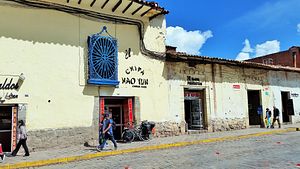Over the past two decades, Peruvian cuisine has become a worldwide phenomenon with the help of government initiatives and celebrity chefs. Its rise has ignored, however, some of the more fascinating hybrids found within the Peruvian food genre: Chifa and Nikkei.
The word “Chifa” comes from the Chinese “chi fan,” meaning “to eat, to have a meal,” and has evolved over the past two centuries from the cooking knowledge brought to Peru by Chinese immigrants. Similarly, “Nikkei” originates from the name of Japanese emigrants and their descendants abroad, and evolved as Japanese migrants fused their traditional styles of food preparation with local Peruvian techniques and ingredients. These two spin-offs of Peruvian cuisine represent the similar yet divergent narratives of the two dominant Asian immigrant cultures in Peru.
Chifa is the product of a longstanding cultural, political, and economic connection between Peru and China. The first Chinese immigrants to Peru were sent to relieve a labor shortage in the 1840s and 1850s, following the abolition of slavery and the belief by Peruvian authorities that local indigenous people were “not suited” to work in the coastal sugarcane and cotton industries. Although Peruvian authorities considered importing European workers to fill the labor gap, they determined that European workers would be unwilling to work under the grueling hacienda conditions, and instead looked to Asia. Peru originally sought workers from the Pacific Islands, considering the Spanish empire’s colonization of the Philippines, but early arrivals of Pacific Islander workers quickly died from illness.
China, however, was a much more promising market for labor. The ongoing First Opium War compelled locals to immigrate, and the poverty in the southern regions allowed Peruvians to take advantage of illiterate Chinese, luring them to South America with promises that they would be well compensated for hacienda work. In reality, Chinese were transported to Peru in conditions similar to those of earlier slave ships from Africa. Up to a third of the Chinese passengers died en route due to the food and illness.
Japanese immigration stories to Peru are somewhat comparable to their Chinese counterparts, with important distinctions that ultimately determined the improved status of Japanese immigrants. Whereas the Chinese came as illiterate laborers, the Japanese arrived only after Peru had been reprimanded for its deception of Chinese immigrants. From this starting point, these two Asian-Peruvian populations continued to evolve on different courses, resulting in two different cultural mixings of Asian-Latino culture.
The Japanese community in Peru was decidedly more insular than the Chinese community for several reasons. First, although the Japanese who chose to immigrate to Peru were not wealthy, they were literate and able to negotiate the passage of Japanese women to Peru. Japanese immigrants were thus able to marry within the Japanese community, preserving the use of the Japanese language. As a result, Japanese-Peruvians have been more successful in maintaining links to their Japanese roots. For example, the most infamous Japanese-Peruvian, Alberto Fujimori, ruled Peru as a dictator president from 1990-2000 with a distinctly Japanese surname. He and his daughter, Keiko Fujimori, have come to the forefront as some of the most well-known Japanese-Peruvians through human rights violations and corruption charges.
The first Chinese immigrants to Peru, on the other hand, were mostly male laborers and many married Peruvian women. Even if Chinese immigrants had intermarried within the Chinese community, they spoke a number of different dialects hailing from several regions in southern China.
The early “hardworking” stereotypes for both Chinese-Peruvians and Japanese-Peruvians originate from the early 20th century, when members of these two immigrant groups were largely agricultural laborers. Many Chinese immigrants eventually escaped their contracted jobs, and used the capital they had earned as seed money to start businesses, such as corner stores, grocery stores, and Chifa restaurants. Through entrepreneurial ventures, these now Chinese-Peruvians gained a reputation for diligence that still clings to them.
Once Japanese workers arrived, they spent less time in the fields, leaving work as manual laborers after only a few years to move to the city and start businesses in general stores, hair salons, and flower shops, among other areas. Considering Japanese-Peruvians were able to get on their feet so quickly, they were also known for being highly organized. They formed business and social organizations — often with support from the Japanese government — that gave them greater power in society. This power has remained over generations, allowing many Japanese-Peruvians to social climb and remain relatively powerful in the country today. Nikkei further embodies this reality as it has grown in popularity worldwide as a form of luxury cuisine, while Chifa still remains largely confined to the Andean region.
Although China’s rise inevitably implies Chinese influence will continue to grow in Peru, it is a recent phenomena that has yet to fully manifest. In the meantime, the third wave of richer Chinese immigrants in the 1980s continues to define the current pecking order in Peruvian society. The cultural metaphor of Asian-Latino cuisine perfectly embodies the current reality of China’s lagging development compared to its Japanese competition: While Chifa generally remains relegated to small, mom and pop store status, Nikkei continues to ride the wave of Japanese opulence that had a decades-long headstart in Peru.
Teresa Kennedy holds a BA in Anthropology & Peace Studies from the University of Notre Dame and is currently in her second year as a master’s student at Peking University’s Yenching Academy. Her research focuses on China-Latin America relations, specifically in the areas of corporate social responsibility, environmental protection, and human rights.
Layne Vandenberg is a Ph.D. candidate in the King’s College London and University of Hong Kong Joint Ph.D. Programme. She graduated from the Yenching Academy at Peking University with a Master of Laws in International Relations.

































